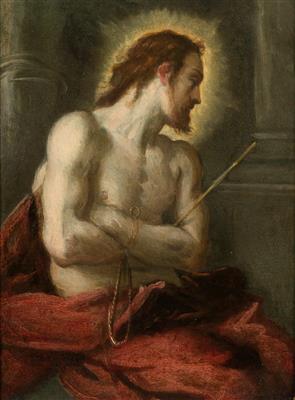Andrea Schiavone

(Zadar? c. 1510–1563 Venice)
Ecce Homo,
oil on copper, 28 x 21.7 cm, framed
We are grateful to Professor Francis L. Richardson for confirming the attribution on the basis of a high resolution digital photograph.
Professor Richardson dates the present painting to the artist’s late period, perhaps 1560-61. The very late Padua Ecce Homo seems to be the closest counterpart among Schiavone’s previously known works. The richness of colour and textures in the present composition are also reminiscent of the larger and more elaborate Ecce Homo in the Steffanoni Collection, and of the Dresden Lamentation, but both are most probably earlier than the present work. The effect of Christ’s profile silhouetted against a golden aureole is frequent in Schiavone’s oeuvre and may be compared with the Christ of the Road to Emmaus in San Sebastiano in Venice, datable by document to after 1557.
Andrea Meldolla, also known as Andrea Schiavone, was born in the Venetian-ruled city of Zara in Dalmatia, now Zadar in Croatia. His family was originally from Meldola, a small town close to the city of Forlì in Romagna. By the late 1530s Schiavone seems to have been established in Venice. Schiavone’s first surviving paintings and etchings probably date from c. 1538–40; they show that he was strongly influenced by Parmigianino and Central Italian Mannerists in figural and compositional modes, but he was also a strikingly daring exponent of Venetian painterly techniques; he employed an equally free technique in etching. His technical experiments were emulated by 17th-century etchers such as Jacques Bellange, Giovanni Benedetto Castiglione and Rembrandt. Schiavone’s mature paintings (c. 1553–63), in which his inventive handling of paint created rich, subtle and complex pictorial fabrics, were influential for Jacopo Bassano, Palma Giovane, El Greco and other artists of the next generation. Still more significantly, they provided precedents for Titian’s late style. Few of his paintings are documented; this may be because, as Vasari states, he mostly worked for private clients.
We are grateful to Professor Francis L. Richardson for his help in cataloguing the present painting.
09.04.2014 - 18:00
- Realized price: **
-
EUR 14,940.-
- Estimate:
-
EUR 12,000.- to EUR 15,000.-
Andrea Schiavone
(Zadar? c. 1510–1563 Venice)
Ecce Homo,
oil on copper, 28 x 21.7 cm, framed
We are grateful to Professor Francis L. Richardson for confirming the attribution on the basis of a high resolution digital photograph.
Professor Richardson dates the present painting to the artist’s late period, perhaps 1560-61. The very late Padua Ecce Homo seems to be the closest counterpart among Schiavone’s previously known works. The richness of colour and textures in the present composition are also reminiscent of the larger and more elaborate Ecce Homo in the Steffanoni Collection, and of the Dresden Lamentation, but both are most probably earlier than the present work. The effect of Christ’s profile silhouetted against a golden aureole is frequent in Schiavone’s oeuvre and may be compared with the Christ of the Road to Emmaus in San Sebastiano in Venice, datable by document to after 1557.
Andrea Meldolla, also known as Andrea Schiavone, was born in the Venetian-ruled city of Zara in Dalmatia, now Zadar in Croatia. His family was originally from Meldola, a small town close to the city of Forlì in Romagna. By the late 1530s Schiavone seems to have been established in Venice. Schiavone’s first surviving paintings and etchings probably date from c. 1538–40; they show that he was strongly influenced by Parmigianino and Central Italian Mannerists in figural and compositional modes, but he was also a strikingly daring exponent of Venetian painterly techniques; he employed an equally free technique in etching. His technical experiments were emulated by 17th-century etchers such as Jacques Bellange, Giovanni Benedetto Castiglione and Rembrandt. Schiavone’s mature paintings (c. 1553–63), in which his inventive handling of paint created rich, subtle and complex pictorial fabrics, were influential for Jacopo Bassano, Palma Giovane, El Greco and other artists of the next generation. Still more significantly, they provided precedents for Titian’s late style. Few of his paintings are documented; this may be because, as Vasari states, he mostly worked for private clients.
We are grateful to Professor Francis L. Richardson for his help in cataloguing the present painting.
|
Buyers hotline
Mon.-Fri.: 10.00am - 5.00pm
old.masters@dorotheum.at +43 1 515 60 403 |
| Auction: | Old Master Paintings |
| Auction type: | Saleroom auction |
| Date: | 09.04.2014 - 18:00 |
| Location: | Vienna | Palais Dorotheum |
| Exhibition: | 29.03. - 09.04.2014 |
** Purchase price incl. buyer's premium and VAT
It is not possible to turn in online buying orders anymore. The auction is in preparation or has been executed already.
